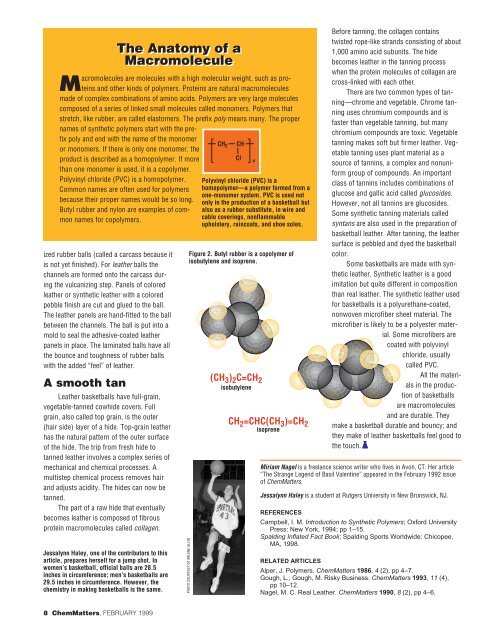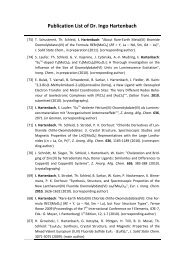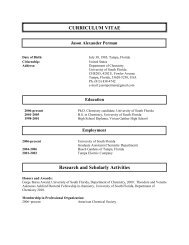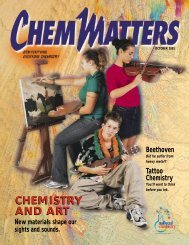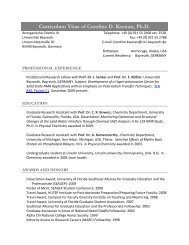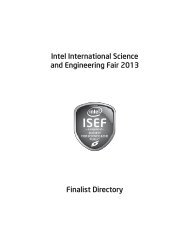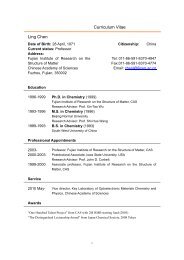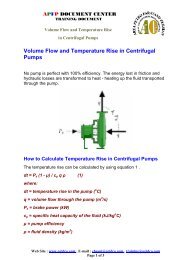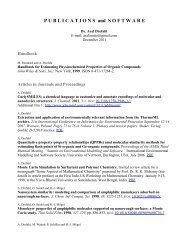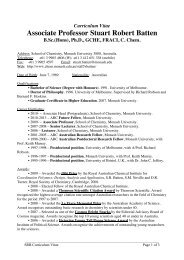Sports Drinks: Don't Sweat the Small Stuff - American Chemical ...
Sports Drinks: Don't Sweat the Small Stuff - American Chemical ...
Sports Drinks: Don't Sweat the Small Stuff - American Chemical ...
You also want an ePaper? Increase the reach of your titles
YUMPU automatically turns print PDFs into web optimized ePapers that Google loves.
ized rubber balls (called a carcass because it<br />
is not yet finished). For lea<strong>the</strong>r balls <strong>the</strong><br />
channels are formed onto <strong>the</strong> carcass during<br />
<strong>the</strong> vulcanizing step. Panels of colored<br />
lea<strong>the</strong>r or syn<strong>the</strong>tic lea<strong>the</strong>r with a colored<br />
pebble finish are cut and glued to <strong>the</strong> ball.<br />
The lea<strong>the</strong>r panels are hand-fitted to <strong>the</strong> ball<br />
between <strong>the</strong> channels. The ball is put into a<br />
mold to seal <strong>the</strong> adhesive-coated lea<strong>the</strong>r<br />
panels in place. The laminated balls have all<br />
<strong>the</strong> bounce and toughness of rubber balls<br />
with <strong>the</strong> added “feel” of lea<strong>the</strong>r.<br />
A smooth tan<br />
Lea<strong>the</strong>r basketballs have full-grain,<br />
vegetable-tanned cowhide covers. Full<br />
grain, also called top grain, is <strong>the</strong> outer<br />
(hair side) layer of a hide. Top-grain lea<strong>the</strong>r<br />
has <strong>the</strong> natural pattern of <strong>the</strong> outer surface<br />
of <strong>the</strong> hide. The trip from fresh hide to<br />
tanned lea<strong>the</strong>r involves a complex series of<br />
mechanical and chemical processes. A<br />
multistep chemical process removes hair<br />
and adjusts acidity. The hides can now be<br />
tanned.<br />
The part of a raw hide that eventually<br />
becomes lea<strong>the</strong>r is composed of fibrous<br />
protein macromolecules called collagen.<br />
8 ChemMatters, FEBRUARY 1999<br />
The Anatomy of a<br />
Macromolecule<br />
Macromolecules are molecules with a high molecular weight, such as proteins<br />
and o<strong>the</strong>r kinds of polymers. Proteins are natural macromolecules<br />
made of complex combinations of amino acids. Polymers are very large molecules<br />
composed of a series of linked small molecules called monomers. Polymers that<br />
stretch, like rubber, are called elastomers. The prefix poly means many. The proper<br />
names of syn<strong>the</strong>tic polymers start with <strong>the</strong> prefix<br />
poly and end with <strong>the</strong> name of <strong>the</strong> monomer<br />
or monomers. If <strong>the</strong>re is only one monomer, <strong>the</strong><br />
CH2 CH<br />
product is described as a homopolymer. If more<br />
than one monomer is used, it is a copolymer.<br />
Cl n<br />
Polyvinyl chloride (PVC) is a homopolymer. Polyvinyl chloride (PVC) is a<br />
Common names are often used for polymers<br />
because <strong>the</strong>ir proper names would be so long.<br />
homopolymer—a polymer formed from a<br />
one-monomer system. PVC is used not<br />
only in <strong>the</strong> production of a basketball but<br />
Butyl rubber and nylon are examples of com- also as a rubber substitute, in wire and<br />
mon names for copolymers.<br />
cable coverings, nonflammable<br />
upholstery, raincoats, and shoe soles.<br />
Jessalynn Haley, one of <strong>the</strong> contributors to this<br />
article, prepares herself for a jump shot. In<br />
women’s basketball, official balls are 28.5<br />
inches in circumference; men’s basketballs are<br />
29.5 inches in circumference. However, <strong>the</strong><br />
chemistry in making basketballs is <strong>the</strong> same.<br />
Figure 2. Butyl rubber is a copolymer of<br />
isobutylene and isoprene.<br />
PHOTO COURTESY OF ARLENE ALLIN<br />
(CH 3) 2C=CH 2<br />
isobutylene<br />
CH 2=CHC(CH 3)=CH 2<br />
isoprene<br />
Before tanning, <strong>the</strong> collagen contains<br />
twisted rope-like strands consisting of about<br />
1,000 amino acid subunits. The hide<br />
becomes lea<strong>the</strong>r in <strong>the</strong> tanning process<br />
when <strong>the</strong> protein molecules of collagen are<br />
cross-linked with each o<strong>the</strong>r.<br />
There are two common types of tanning—chrome<br />
and vegetable. Chrome tanning<br />
uses chromium compounds and is<br />
faster than vegetable tanning, but many<br />
chromium compounds are toxic. Vegetable<br />
tanning makes soft but firmer lea<strong>the</strong>r. Vegetable<br />
tanning uses plant material as a<br />
source of tannins, a complex and nonuniform<br />
group of compounds. An important<br />
class of tannins includes combinations of<br />
glucose and gallic acid called glucosides.<br />
However, not all tannins are glucosides.<br />
Some syn<strong>the</strong>tic tanning materials called<br />
syntans are also used in <strong>the</strong> preparation of<br />
basketball lea<strong>the</strong>r. After tanning, <strong>the</strong> lea<strong>the</strong>r<br />
surface is pebbled and dyed <strong>the</strong> basketball<br />
color.<br />
Some basketballs are made with syn<strong>the</strong>tic<br />
lea<strong>the</strong>r. Syn<strong>the</strong>tic lea<strong>the</strong>r is a good<br />
imitation but quite different in composition<br />
than real lea<strong>the</strong>r. The syn<strong>the</strong>tic lea<strong>the</strong>r used<br />
for basketballs is a polyurethane-coated,<br />
nonwoven microfiber sheet material. The<br />
microfiber is likely to be a polyester material.<br />
Some microfibers are<br />
coated with polyvinyl<br />
chloride, usually<br />
called PVC.<br />
All <strong>the</strong> materials<br />
in <strong>the</strong> production<br />
of basketballs<br />
are macromolecules<br />
and are durable. They<br />
make a basketball durable and bouncy; and<br />
<strong>the</strong>y make of lea<strong>the</strong>r basketballs feel good to<br />
<strong>the</strong> touch.<br />
Miriam Nagel is a freelance science writer who lives in Avon, CT. Her article<br />
“The Strange Legend of Basil Valentine” appeared in <strong>the</strong> February 1992 issue<br />
of ChemMatters.<br />
Jessalynn Haley is a student at Rutgers University in New Brunswick, NJ.<br />
REFERENCES<br />
Campbell, I. M. Introduction to Syn<strong>the</strong>tic Polymers; Oxford University<br />
Press: New York, 1994; pp 1–15.<br />
Spalding Inflated Fact Book; Spalding <strong>Sports</strong> Worldwide: Chicopee,<br />
MA, 1998.<br />
RELATED ARTICLES<br />
Alper, J. Polymers. ChemMatters 1986, 4 (2), pp 4–7.<br />
Gough, L.; Gough, M. Risky Business. ChemMatters 1993, 11 (4),<br />
pp 10–12.<br />
Nagel, M. C. Real Lea<strong>the</strong>r. ChemMatters 1990, 8 (2), pp 4–6.


